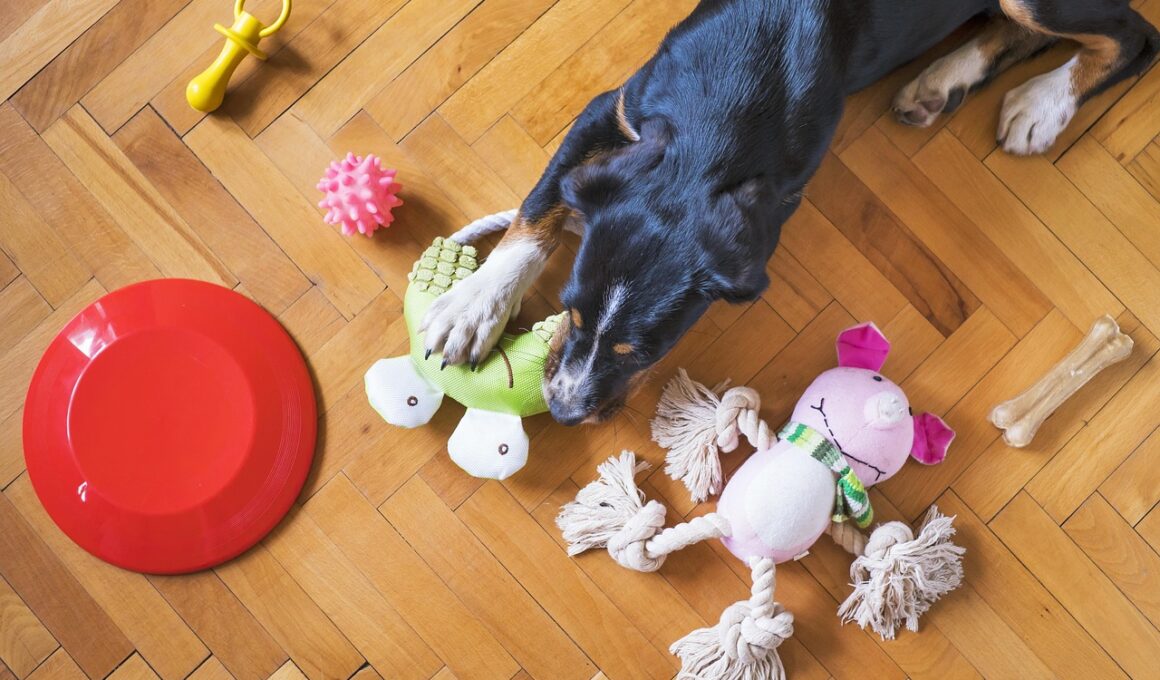How to Use Household Items to Create Fun Dog Toys
Creating engaging toys for your dog can be both a fun and economical endeavor. Many household items can easily be transformed into wonderful toys that provide mental and physical stimulation for your furry friend. For instance, old t-shirts can be braided to create a sturdy tug toy. Simply cut the shirt into strips and braid them together tightly. You can even add a tennis ball in the center for added excitement! Additionally, plastic bottles can be used to make crinkle toys. Just place treats inside, and your dog will enjoy the sound as well as a challenge of getting them out. Using such materials not only saves money but also encourages creativity as you experiment with different designs and styles. Remember to ensure that these toys do not pose any choking hazards or sharp edges. Always supervise your pet during playtime with homemade toys to ensure their safety. The joy of seeing your dog play with a toy you created from everyday items is immeasurable. This activity can also strengthen the bond between you and your canine companion. Let’s explore some more ideas that could inspire your next DIY project!
Safe Household Materials for Dog Toys
When crafting dog toys from household items, safety must be your first priority. Avoid any materials that could splinter, break, or cause choking hazards. Soft old blankets or towels, for example, can be cut and tied into knots, creating a simple yet effective tug toy. Ensure these fabrics are washed and free from harmful residues or chemicals. Tennis balls are another excellent option, as they are durable and engaging for dogs. However, keep an eye on their condition; if they start to break down, it’s time to toss them out. Additionally, natural items like rope or cotton twine can be braided into chew toys. Just make sure they are untreated and safe for pets. Cardboard boxes can provide hours of fun; consider cutting holes for your dog to explore. Always ensure that any toys made from cardboard are free of staples or glue that can be ingested. Remember to experiment with different textures and sizes to find what captivates your dog’s interest the most. Keeping play engaging challenges the dog’s mind, making your DIY projects both rewarding and essential.
Another exciting option for dog toys is using empty egg cartons. These can be filled with treats and let your dog figure out how to access them. This mental stimulation can keep your dog entertained for hours. If you have some old socks, you can also create a simple sock toy by filling one with another sock or stuffing it with crumpled plastic. Be sure to securely knot the top to prevent your dog from accessing the filling inside. Crumpled paper also works well for dogs who enjoy ripping and shredding. Just ensure they are non-toxic and avoid glossy-type papers. To make a more interactive toy, you can use an empty water bottle as a fetch toy; most dogs love the sound it makes! Make sure you supervise playtime, and always check for any loose parts that might come off. Additionally, using a hula hoop set on the ground can become a fun jumping or running obstacle course for your dog. These activities not only challenge their physical agility but also foster enjoyment through exercise.
Keeping Playtime Engaging
Once you’ve created some DIY toys for your dog, it’s important to rotate them to maintain their interest. Dogs can get bored with the same toys over time, which may lead to undesirable behaviors. By regularly changing out the toys, you keep playtime fresh and exciting. Consider implementing a system: one week, use the toys you made, and the next week switch them for previously made toys. This rotation can be an easy task. Make sure you observe which toys your dog enjoys the most, as this can help in future projects. If you find your pup particularly loves a certain toy, you can even try to replicate similar toys in new styles. Interactive playtime can enhance your dog’s physical health and emotional well-being, making it vital to engage them consistently. Furthermore, you can incorporate hidden treats into toys to increase the challenge. Involve your family members in creating new items, making this a shared project. Not only does this spark creativity, but it also brings everyone closer. Enjoy reflecting the love you have for your dog into making these special toys regarding safety and engagement.
When engaging in DIY toy creation, it’s also a good idea to embed training into the play. Using your homemade toys during training sessions can reinforce listening skills and obedience while making the learning process fun. A well-made tug toy can be an effective reward for positive behavior. Additionally, stashing treats inside toys can encourage your dog to work harder to achieve getting to the prize. You can further customize these toys by adding your dog’s favorite scents or even treats they love. This personalized touch can make your dog more excited about the toy and enhance their play. Always remember that supervision is crucial, especially during training to prevent any mishaps. While homemade toys can be very engaging, your dog’s safety remains paramount. It’s essential to keep testing their toys over time to assess wear and tear. After all, the goal is to cultivate a friendly and fun environment through safe play. Furthermore, don’t forget to incorporate your dog’s preferences into the design process. Their distinct likes will guide you in creating a more appealing toy for them.
Extra Tips for DIY Dog Toys
To make the most of your DIY dog toys, organize your play areas with a designated section for these items. Clear spaces allow you to evaluate the effectiveness of each toy. Consider creating a toy box or container from a wooden crate where you can store your creations. This organization helps keep toys clean and in one place while allowing easy access. Additionally, feel free to personalize your creations by painting or decorating them safely for aesthetic appeal. You can even use non-toxic materials for this purpose, ensuring your designs are pet-friendly. When crafting these toys, consider different sizes for different breeds, tailoring them accordingly. Always double-check for potential hazards during your crafting sessions. It’s crucial to avoid any materials that can weaken quickly under play. Taking the time to research and plan your DIY projects will pay off significantly in your dog’s joy and engagement. These efforts reflect the bond you share with your furry friend. Tailoring playtime will enrich your pet’s mental stimulation and overall health, fostering a more active lifestyle. So let’s get crafting and make some wonderful toys!
In conclusion, turning household items into dog toys is both a rewarding and sustainable approach to keeping your furry friends entertained. Not only does this practice save money, but it also allows you to provide engaging, personalized play experiences. As you dive into each crafting project, consider your dog’s preferences and safety to ensure they reap the benefits of their new toys. The joy that comes from creating something special for your pet is deeply fulfilling, and it can strengthen your bond. Doggoholic innovation—by making toys from items around the house, you tap into your creativity while addressing your dog’s needs for engagement and stimulation. Emphasizing the value of play, it’s clear how much fun you can have while contributing positively to your pet’s quality of life. Whether a simple tug toy made from an old shirt or a puzzle made from cardboard, every effort you put in translates to fun for your dog. Remember to stay proactive in monitoring their behaviors while playing and to swap toys to keep things fresh. With these tips and ideas at hand, you’re all set to embark on your DIY dog toy journey!


